Why Fiscal Efficiency, Not Fiscal Fear, Will Define the Next Decade
The Dynamics and
Current State of Global Sovereign Debt:
Public spending come to the forefront of the paper seem as it is the catalyst
for deficits.and sovereign debt increases. Government debt is a global problem
facing countries to varying degrees, depending on the level of monetary
sovereignty.
As at 2024, Japan's debt to GDP was 250%, the US, 120%, France 110%, Australia
45%
For EM; China leads at near 90%, with Brazil and India coming a close second
and third, and South Africa debt/GDP ratios at ~70%..
Developed economies with more monetary sovereignty seems to have saturated the
market, and need fiscal consolidation to foster economic
stability.
For emerging market economies, who's debt is currently sought after by yield
hungry investors, a balanced approach is necessary to avoid the dent trap
situation currently plaguing DMs.
Frontier markets must curb fiscal excesses and improve spending efficiency to
support foreign exchange stability and economic growth.
All these realities
point to one essential necessity – the need for an improved and effective and
efficient public sector.
Debt Risk Profiles:
Different categories of economies face distinct risks tied to the composition and nature of their debt:
Developed markets (DMs): Face risks of currency debasement relative to the “mother asset” (real goods, gold, or alternative stores of value), as sustained fiscal expansions test monetary credibility.
Emerging markets (EMs): Confront interest rate and refinancing risks, as high yields are demanded by investors to compensate for exchange rate exposure.
Frontier markets (FMs): Are prone to liquidity crises and exchange rate losses for investors when unchecked spending and weak reserves undermine fiscal credibility.
Public Sector
Efficiency:
Public institutions are not inherently driven by financial profit, except in
cases where they are directly engaged in industrial or commercial activity.
Their orientation is toward short- and long-term economic gains, including
social welfare, infrastructure, and human capital accumulation.
The goal of the state, is not to crowd out the private sector, but to enable and enrich it, as no government can sustainably employ or finance beyond a certain share of its labor force and output.
As a result of this
detachment from financial and monetary profitability, these institutions have
the tendency to overspend and underspend, leading to a miss-allocation of
capital, or public sector malinvestments.
The more the public sector malinvests or involve I'm wasteful spending, the
lesser the marginal efficiency of capital. This excerbates the crowding-out
effects of deficit spending to find fiscal expansions.
Where government spend less on industrial development, and make no efforts at
improving the economic complexity, spending will continue to outweigh revenue,
driving the economy deeper into debt.
Populist fiscal behavior that emphasize politically appealing rather than
productive spending,.can worsen this imbalance, raising deficits and
accelerating debt burdens.
Debt Traps and Overhangs:
As debt service obligations expand to occupy a larger share of budgetary expenditure, they crowd out growth-enhancing investments in infrastructure, education, and productivity.
The longer this goes
on, the more less effective fiscal policy becomes, and the more growth is stifled. As not only
is government borrowing crowding-out private sector credit, but it is also restrictive of growth enhancing
spending.
This process gradually transforms fiscal policy from an engine of growth into a
maintenance mechanism for past liabilities.
Over time, fiscal effectiveness diminishes, as not only does government borrowing crowd out private sector credit, it also restricts fiscal space for future expansion.The outcome is a debt overhang: where the perceived or actual burden of debt suppresses new investment and growth potential.
The Significance of
Public Sector Efficiency:
Public sector inefficiency directly erodes the marginal efficiency of capital,
as an increasing share of output is devoted to debt servicing instead of new productive activity.
This leads to a feedback loop, where weaker output leads to weaker revenue, prompting even more borrowing.Thus, improving institutional efficiency becomes the starting point for restoring fiscal sustainability.
So naturally
improving the efficiency of pubic sector institutions becomes a starting point
for improving marginal efficiency of capital and overcoming debt
overhangs.
Efficiency, however, is not merely about cost-cutting, more importantly it entails the capacity to spend well, this
is only possible with;
- A transparent and competitive procurement processes,
- Leakage prevention and anti-corruption measures
- Policy alignment and incentive structures that reward outcomes over
disbursement
- Long-term fiscal planning that links expenditure with growth objectives
Only by improving public sector efficiency can nations raise the marginal efficiency of capital, restore fiscal credibility, and escape recurring debt overhangs.
Author's Notes, Remarks, and Conclusion;
The global sovereign debt landscape in 2024, and so far into 2025 shows both the limits and potential of fiscal policy. For advanced economies, monetary sovereignty offers the capacity to borrow but not immunity from the costs of excess. For emerging and frontier markets, external dependence and limited buffers make fiscal missteps more punishing.
Yet across all categories, the solution converges on one principle: efficiency over austerity. Sustainable fiscal health will depend less on the scale of spending and more on the quality of expenditure (i.e., how effectively states convert public outlays into growth, productivity, and resilience.)
In that sense, public sector efficiency is not merely an administrative goal but the foundation of fiscal sustainability and economic sovereignty in a world where debt has become both an instrument and a burden.





Comments
Post a Comment